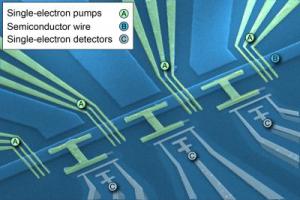Apr 1 2014
Quantum standards for the electrical units the volt and the ohm have been available for more than two decades. However, for the electrical base unit of the international system of units (SI) the ampere, such a "new" quantum standard is still lacking. Within the planned "new" SI the base unit of current will then be traced to the corresponding fundamental constant – the electric charge of a single electron.
In time for the maybe critical decisions on the change to the "new" SI at the Conférence Internationale des Poids et Mesures this November, a group of scientists from the Physikalisch-Technische Bundesanstalt (PTB) has succeeded in developing a current standard that not only generates a clocked single-electron current, but also simultaneously measures this current independently. For this considerable advance, the scientists under Hans Werner Schumacher's lead have now been awarded the Hermann von Helmholtz Prize. This prize is endowed with 20,000 euros and is deemed one of the most significant international awards in the field of metrology – the science of accurate measurement.
 This semiconductor structure can measure single electrons and their respective charge. Four "single-electron pumps" are integrated onto the chip; each of them has three gate electrodes (colored in green) crossing a semiconductor wire (blue). The pumped electrons are detected with the aid of three single-electron detectors (grey). Credit: (Fig.: PTB)
This semiconductor structure can measure single electrons and their respective charge. Four "single-electron pumps" are integrated onto the chip; each of them has three gate electrodes (colored in green) crossing a semiconductor wire (blue). The pumped electrons are detected with the aid of three single-electron detectors (grey). Credit: (Fig.: PTB)
The ampere has for long been a problematic unit: in spite of its being a base unit – and thus a basis for all electric measurements – it can only indirectly be realized in a metrologically accurate way via the derived electric units the volt and the ohm. Those two units can be accurately realized on the basis of fundamental constants – the Josephson constant (for the volt) and the von Klitzing constant (for the ohm). Scientists worldwide have been putting great effort into doing the same with the ampere with the appropriate fundamental constant being the charge of a single electron. A quantum standard for the ampere could in principle be realized by controlling the capturing and emission of single electrons in an electronic nano-circuit. The circuit could then serve as a so-called "single-electron pump", a device which was first designed in the 1990s. However, only recently, scientists from PTB have developed an optimized single-electron pump allowing both the generation of a clocked single-electron current and its independent measurement with minimum uncertainty.
To this end, Prof. Schumacher and his team developed a so-called "self-referenced" quantum current source. This is a semiconductor circuit which is equipped with several pumps and detectors and is operated near absolute zero temperature. The single-electron pump is a minuscule semiconducting island with two current leads. In pumping operation, first an electron coming from the current lead on the left is loaded onto the island and then released into the other current lead on the right. If this procedure is repeated periodically at a clock frequency, then a current is generated that is only determined by the clock frequency and the single-electron charge. Such semiconductor circuits have already been considered as promising candidates for the realization of the ampere for some time.
Prof. Schumacher's group has now succeeded in measuring, for the first time, the current that is involved in each single-electron jump. Their pump transports only a few dozen electrons per second. This is slow enough to allow precision measurements. As the scientific journal "Nature" announced some time ago, PTB's new development represents a decisive step towards a new definition of the ampere. It furnishes proof that the realization of the new definition on the basis of the charge of a single electron can indeed work.
Additionally, the newly developed current source allows the generation of validated small currents down to the attoampere range (10-18 ampere) with a clearly lower measurement uncertainty than would be achievable using conventional current measurement methods. Hence, it enables precision calibrations of measuring instruments for small currents, as are used, for example, in personnel dosimetry for radiation protection.
The Helmholtz Prize, awarded every two to three years by the Helmholtz-Fonds (Helmholtz Foundation) and the Stifterverband für die Deutsche Wissenschaft (Donors' Association for the Promotion of Science and Humanities in Germany), is a token of the highest esteem to scientists for precision measurements in physics, chemistry and medicine. This year, the prize is endowed with 20,000 euros and will be presented on 24 June 2014 following the Helmholtz Symposium (entitled "Transparency: Measuring with X-rays") at the Haus der Wissenschaft, Braunschweig. es/ptb
The prize winners
Lukas Fricke, Dr. Bernd Kästner, Dr. Ralf Dolata, PD Dr. Frank Hohls, PD Dr. Hans Werner Schumacher (all from the Physikalisch-Technische Bundesanstalt, PTB)